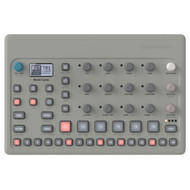Elektron — Model:Cycles
by Anatol Locker
When it comes to playing live, you can’t go wrong with an Elektron machine. Once you’ve wrapped your head around the sequencer, they are workhorses on stage and in the studio. Also, they sound good, especially if you combine them with analog gear. The Model:Cycles is the latest and smallest of Elektron’s FM machines and is also the most affordable FM hardware groove box currently on the market.
The highly underrated Digitone Keys [the most fun FM synth this author has ever played], and its little brother, the Digitone, share a musically tamed subset of FM algorithms. The Model:Cycles won’t give you the full monty either – on the contrary, it‘s toned down even more and uses six FM models tailored to specific needs. KICK, SNARE, METAL, and PERC are obvious choices for creating a drum loop, while “Tone“ and “Chord“ are meant to help you with melodic bits. Once you start tweaking the synth’s core parameters via “Color“, “Shape“, “Sweep“ and “Contour“, you’ll find the sonic palette is more limited than other FM synths, but the results still sound good. Thankfully, some models go beyond what their names imply. “Tone“, a 2-Op FM model, and “Metal“ are especially rewarding, as they bring back memories of the Machinedrum and the Monomachine’s FM algorithms. On the FX side, you can add reverberation, delay and saturation, which sound decent and can be altered via dedicated knobs.
Like with the Model:Samples, the instrument’s layout is very clear and consistent, and the small screen is readable from all angles. As most people seem to find the PC-like beigeness a bit dull, Elektron provides you with stickers to personalize your instrument.
Despite its limits, the Model:Cycles doesn’t sound as “beige“ as you might think, and can become colorful, metallic, sizzly, and intense, but never veers toward a really bright, warm, and shiny sound. The models are good for abstract drums, but when it comes to pure tonal material, you have to dive deeper to get something new and unheard.
As with all Elektron machines, the 6-track sequencer is a real powerhouse. It offers all the goodies of its bigger brothers with pattern locks, various fill modes, and pattern chaining, which is not savable, though. Nudging and retriggering notes will make your patterns less static and a dedicated “Chance“ knob lets you thin out notes. If you wish to do so, every track can have its own timing for polyrhythmic greatness. Tweaking sounds with the 15 dedicated knobs comes very naturally – spend an hour with the instrument, and you know its layout by heart. And if you want to go back to the original value after tweaking, there’s an extra button for that, which is excellent for live use.
The most obvious drawback of the Model:Cycles are its meager modulation sources; there is just one plain vanilla LFO! You can compensate a bit by using the Parameter Lock feature [“locking in tweaked steps“], but this needs some extra thinking. Also, the Model:Cycles doesn’t offer attack on its amp envelope, so if you want to fade in a pad sound, you’ll have to modulate the volume with your only LFO. That‘s a bummer.
Hooking up the Model:Cycles to a Eurorack modular turned out to be great fun and enriched the analog oscillator sounds with clicky beats and the occasional chord, and while it did its pattern grinding, I could go wild on the modular. If the pattern got boring or too dominant, I just thinned it out with the Chance parameter and did the opposite to build things up fast again. If you’re looking for an affordable FM-based drum machine and a versatile loop-driven addition to your modular, the Model:Cycles can be a great companion. For bigger tasks and a more diverse sound cosmos though, the Digitone is the better choice.
Price: $299 / €320


